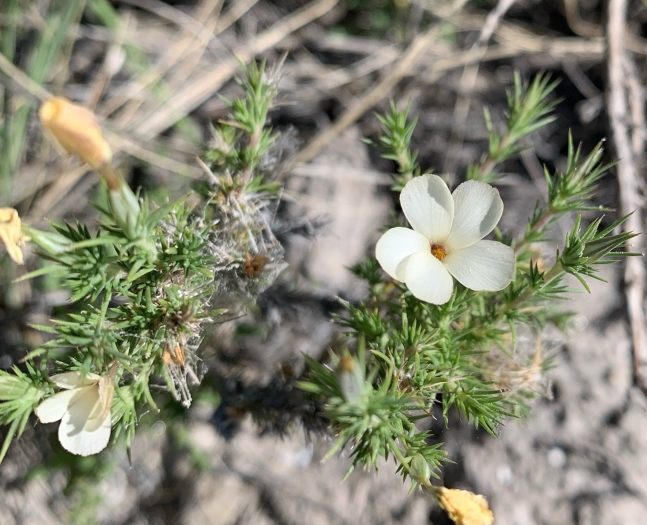Granite Prickly-Phlox
(Linanthus pungens)
Granite Prickly-Phlox (Linanthus pungens)
/
/

Whitney Brook Matson
CC BY 4.0
Image By:
Whitney Brook Matson
Recorded By:
Copyright:
CC BY 4.0
Copyright Notice:
Photo by: Whitney Brook Matson | License Type: CC BY 4.0 | License URL: http://creativecommons.org/licenses/by/4.0/ | Rights Holder: Whitney Brook Matson | Publisher: iNaturalist | Date Created: 2021-06-12T15:13:03Z |






















Estimated Native Range
Summary
Linanthus pungens, commonly known as granite prickly-phlox or granite gilia, is a versatile plant that can function as a shrub or a perennial herb with a woody base. It is native to a variety of habitats in western North America, including montane coniferous forests, pinyon-juniper woodlands, sagebrush steppe, and grasslands, as well as their ecotones. It is particularly adapted to high elevations where it often forms dense mats. This species typically grows erect with stems densely covered in narrow, sharp-pointed leaves. From late spring to early summer, it bears showy, funnel-shaped flowers that are white, cream, yellowish, or pinkish. These flowers open at night and are pollinated by moths, a trait that reflects its adaptation to arid environments where nighttime pollinators are prevalent.
Granite prickly-phlox is valued for its drought tolerance and ability to thrive in poor, shallow, rocky, sandy, and saline soils, making it an excellent choice for xeriscaping and rock gardens. It requires minimal maintenance once established and is appreciated for its fragrant, nocturnal flowers that add interest to the night garden. In cultivation, it prefers full sun and well-drained soils. While it is not commonly afflicted by diseases or pests, it can be sensitive to overwatering and root rot. This plant is also used for erosion control and habitat restoration due to its hardy nature and ecological role as a dominant species in certain areas, such as the white pine-mountain hemlock forests and shrublands in El Dorado County, California, and the sagebrush near the U.S. Sheep Experiment Station in eastern Idaho.CC BY-SA 4.0
Granite prickly-phlox is valued for its drought tolerance and ability to thrive in poor, shallow, rocky, sandy, and saline soils, making it an excellent choice for xeriscaping and rock gardens. It requires minimal maintenance once established and is appreciated for its fragrant, nocturnal flowers that add interest to the night garden. In cultivation, it prefers full sun and well-drained soils. While it is not commonly afflicted by diseases or pests, it can be sensitive to overwatering and root rot. This plant is also used for erosion control and habitat restoration due to its hardy nature and ecological role as a dominant species in certain areas, such as the white pine-mountain hemlock forests and shrublands in El Dorado County, California, and the sagebrush near the U.S. Sheep Experiment Station in eastern Idaho.CC BY-SA 4.0
Plant Description
- Plant Type: Shrub, Herb
- Height: 0.5-1.5 feet
- Width: 1-2 feet
- Growth Rate: Moderate
- Flower Color: Pink, White, Yellow
- Flowering Season: Spring, Summer, Fall
- Leaf Retention: Deciduous
Growth Requirements
- Sun: Full Sun, Part Shade
- Water: Low
- Drainage: Fast
Common Uses
Drought Tolerant, Low Maintenance, Rock Garden, Showy Flowers
Natural Habitat
Native to montane coniferous forests, pinyon-juniper woodlands, sagebrush steppe, grasslands, and their ecotones in western North America
Other Names
Common Names: Granite Gilia, Prickly Phlox, Sharp Linanthus
Scientific Names: , Linanthus pungens, Leptodactylon pungens var. pungens,
GBIF Accepted Name: